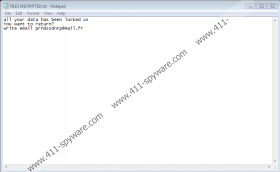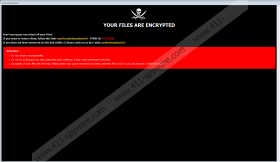Prnds Ransomware Removal Guide
Prnds Ransomware is a vicious threat that might stay on the system even after it finishes encrypting files and displays a ransom note. Specialists say that the malware might be able to reopen itself every time a user restarts his computer and each time it does so, there is a chance that it might start encrypting files that were not enciphered yet. Therefore, our researchers advise not to wait too long and erase Prnds Ransomware if you want your system to be clean and your files safe. To find out more details about how this threat works, where it might come from, or how to delete it, you could read the rest of this article. Also, we can offer our deletion steps that show how you could try to remove the malware manually. If the task is too challenging, do not hesitate to employ a reliable security tool instead.
Let us start with where Prnds Ransomware might come from. Our specialists say that the malicious application could be distributed through different channels. For example, some victims could open it accidentally after interacting with unreliable email attachments or links in messages. Consequently, we advise being extra careful will all data that comes from unreliable sources.
If you have any doubts, remember that you can always scan your downloaded or, anyhow else, encountered files with a reliable antimalware tool to check if they have any malicious components. Another method that could be used to spread this threat is exploiting unsecured RDP or Remote Desktop Protocol connections. Thus, if you must use RDP connections, we advise ensuring that they are secured and well-protected. If you do not, it is advisable to disable them.
Prnds Ransomware may encrypt pictures, photos, text files or other types of documents, and other files that do not belong to the infected device’s operating system. That is because hackers need the infected computer to be bootable. Once the files that the cybercriminals are after are encrypted, the threat should show a window on top of victims’ screen. This pop-up message ought to say that all files were encrypted and that users can decrypt them. The message should explain that to so do, victims need to email cybercriminals their unique ID numbers. Such number ought to be seen both on the ransom note and on every encrypted file as the malware adds it to the extension that it appends on all encrypted files.
Our specialists say that if users contact hackers, they might receive further instructions that may explain how to pay ransom. Hackers may promise to send decryption tools soon after they receive the required payment, but you cannot be sure they will do so. They might not bother to send the promised decryption tools and if they do not, you might lose more than your files. Of course, the decision is yours to make, we only advise not to rush into anything and think carefully about your options. Of course, if you always back up your data, you might not have any need for the decryption tools. Either way, we advise not to leave Prnds Ransomware on your system.
The malicious application might restart with your operating system, which means it could keep encrypting new files. To make sure it does not happen, you could erase Prnds Ransomware manually or with a chosen antimalware tool. If you prefer dealing with it manually, but you need guidance, we can offer our deletion instructions placed below.
Get rid of Prnds Ransomware
- Click Ctrl+Alt+Delete.
- Pick Task Manager and go to the Processes tab.
- Check if there is a process belonging to the ransomware.
- Select it and press the End Task button.
- Close Task Manager.
- Press Win+E.
- Navigate to these directories:
%USERPROFILE%\Desktop
%USERPROFILE%\Downloads
%TEMP% - Find the ransomware’s installer (suspicious recently downloaded file), right-click it, and select Delete.
- Go to these locations:
%LOCALAPPDATA%
%APPDATA%\Microsoft\Windows\Start Menu\Programs\Startup
%ALLUSERSPROFILE%\Microsoft\Windows\Start Menu\Programs\Startup
%ALLUSERSPROFILE%\Application Data\Microsoft\Windows\Start Menu\Programs\Startup - Find suspicious executable files that could belong to the ransomware, right-click them, and press Delete.
- Navigate to these locations:
%APPDATA%\Microsoft\Windows\Start Menu\Programs\Startup
%ALLUSERSPROFILE%\Microsoft\Windows\Start Menu\Programs\Startup
%ALLUSERSPROFILE%\Application Data\Microsoft\Windows\Start Menu\Programs\Startup
%WINDIR%\System32
%APPDATA% - Search for files called Info.hta, right-click them and press Delete.
- Look for files called info.txt, right-click them, and press Delete.
- Close File Explorer.
- Press Win+R.
- Type Regedit and click Enter.
- Go to these locations:
HKEY_LOCAL_MACHINE\SOFTWARE\Microsoft\Windows\CurrentVersion\Run
HKEY_CURRENT_USER\SOFTWARE\Microsoft\Windows\CurrentVersion\Run - Find value names belonging to the malware, for example, mshta.exe, right-click them, and press Delete.
- Close Registry Editor.
- Empty Recycle Bin.
- Restart your computer.
Prnds Ransomware Screenshots:



